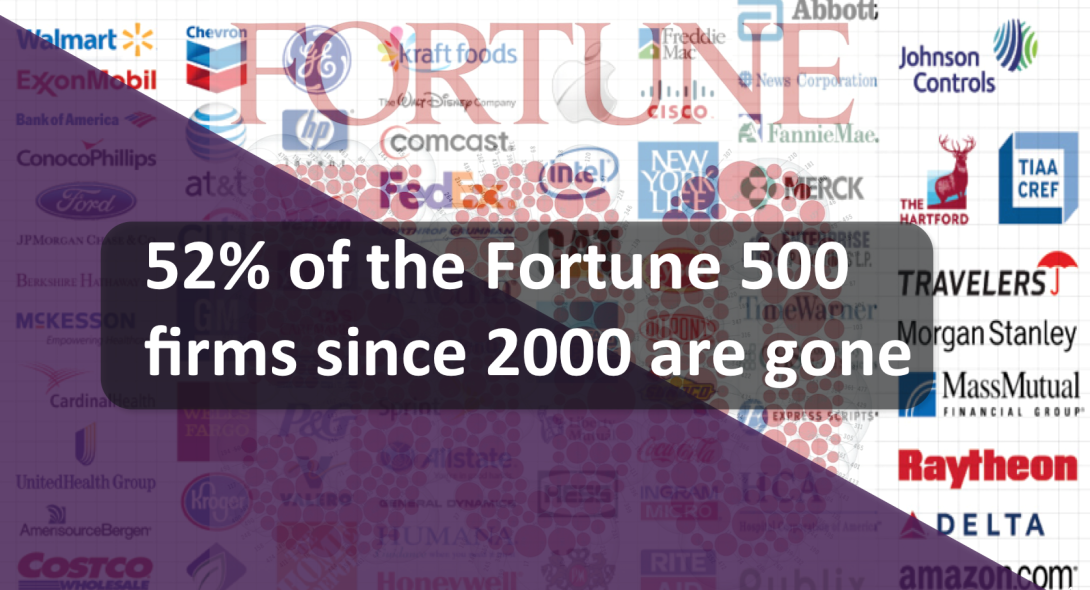
Research Report: Inside The 2015 Boardroom Priorities (Parts 1 & 2)
Boardrooms In Market Leader And Fast Follower Organizations Rapidly Take Action To Address the Digital Chasm Ahead
Constellation Research surveyed over 200 CXO’s and identified 10 board room priorities for 2015. As anticipated, digital transformation has emerged as a significant board room topic and market leaders and fast followers seek guidance on what elements are required in the design to support digital business.
Digital Transformation is defined as methodology in which organizations transform and create new business models and culture with digital technologies. The driver for digital transformation stems from the fact that since 2000, 52 percent of companies in the Fortune 500 have either gone bankrupt, been acquired or ceased to exist.
These market leaders and fast followers surfaced a theme of ten priorities heavily skewed towards the higher end of the Constellation Corporate Hierarchy of Needs (see Figure 1)
Figure 1. The Constellation Corporate Hierarchy Of Needs
Boardroom Priorities Reflect An Urgency For Change At Digital Speed
After categorizing boardroom priorities according to the Constellation Corporate Hierarchy of Needs, 10 trends emerged across all five categories. Of note, a greater number of priorities for 2015 emerged in the higher level of needs. This changed from previous surveys indicate a desire to shift strategy or embark in business transformation (see Figure 2).
Figure 2. 2015 Boardroom Priorities
Brand Priorities Support the Delivery of Authenticity in Both Analog and Digital Worlds
1. Investment in digital presence. Digital personas must not only reflect the brand, but also expand upon the analog experience. Brand conscious leaders invest in the digital experience with an eye towards mass personalization at scale. While advertising plays a key role in carrying out the message, investment in the design of digital experiences emerges as the hot area of investment.
2. Consistent delivery of customer experience (CX). Board members in highly competitive markets emphasize the need to improve and expand customer experience in order to grow lifetime customer value. They realize these initiatives require both a sustainable engagement model through communities and a loyalty dimension through gamification and value exchange. The hottest area of growth is the post sales experience that includes installation, warranty, service, training, migration, and upgrade.
Strategic Differentiation Focuses On Proactive and Reactive Digital Transformation Techniques
3. Digital transformation of the business. Leaders are scrambling to create new business models through disruptive technologies. One trend includes the introduction of new unit – cost business models. These business models seek to deliver the smallest unit of product or service to a customer and then seek subscription models for longer-term predictability. In addition, leaders are hoping to take advantage of the scale of digital to deliver on the long-term goal, which are customer segments of one.
4. Rapid response to non-traditional competitors. With the rise of non-traditional competitors to almost every market segment, boards are asking their management teams to create SWAT teams to proactively identify potential market competitors. The goal – create potential responses to likely market scenarios based on start ups business models and disruptive technologies.
5. Creation of insights driven business models. Expect organizations to deliver 20% of their revenue growth from big data business models by 2020. The brokering of insights as a content provider, network, or arms dealer emerges as new source of competitive differentiation and also revenue stream. Organizations must create the ability to deliver insights on their own and feed information brokers such as Thomson Reuters and Bloomberg.
Preorder Disrupting Digital Business, published by Harvard Business Review Press In Q2 2015. Learn more.
Revenue and Growth Strategies Prepare for Highly Skilled And Inorganic Fueled Strategies
6. Prioritized development of a high performance culture. The war for talent continues at the high end of the hiring spectrum. In fact, the market is highly competitive for the top 10% of the workforce. Why? Despite hiring fewer workers, most organizations prioritize quality over quantity. In addition, the pending retirement of a highly knowledgeable and experienced generation creates a vacuum of skilled workers in not only the top ranks, but also the middle of the employee base.
7. Readiness for inorganic growth. Cheap capital, patent portfolio accumulation global growth ambitions, war for talent, and declining margins drive organizations towards mergers, acquisitions, and joint ventures. Moreover, the elusiveness of organic growth challenges boards to consider mergers and acquisitions as an accelerant for intellectual property, talent, customer base, and partner networks. The goal is to create platform ecosystems and attract partners to co-create and co-innovate.
Cost and Operational Efficiency Remains An Important Pillar Through Automation And Post Merger Integration
8. Mass automation of work and thought. Automation expands into both the low end and high end of the market. Leaders invest in robotics, internet of things, and augmented humanity. The hallowing out of jobs in the middle will expand as machines get smarter and regulatory costs from healthcare to safety increase. Decision management systems gain favor in making more consistent and smart recommendations based on machine learning and algorithms. From supply chains to customer experience, automation advances at a rapid pace of change.
9. Efficiency in post merger integration. With inorganic growth a priority for 2015, boards will measure management teams on their ability to not only complete a merger and acquisition, but also drive out cost, merge product lines, improve up-sell and cross-sell, grow market share, and improve profitability. Experienced leaders plan for scale by building direct and platform capabilities for core and leveraging outsourced services providers for non core requirements.
Regulatory Compliance
10. Cost reduction of regulatory and security compliance. As regulatory compliance proliferates and security threats mushroom, organizations seek capabilities to drive down the cost. Solutions include creating shared services among competitors to address regulatory requirements and common core processes.
The Bottom Line: Digital Darwinism Is Unkind To Those Who Wait
Unfortunately, in almost every segment, the top three competitors control 43 to 71 percent of the market share and 53 to 77 percentage of the profits. In the technology space only 80 companies since 2000 have made the billionaire’s club. Meanwhile, intense competition, short-term shareholder and management thinking, and minimal investment hamper the pace of investment and innovation required by business leaders to survive today’s competitive landscape.
While boards have not been complacent about addressing change, the past five years have shown the difference between those who invested in digital transformation and those who have not. The corporate digital chasm is massive among market leaders, fast followers, and everyone else. Astute board members realize they must invest in transformational change for face a vicious Digital Darwinism.
Your POV.
Ready for digital disruption by starting with mobile? Add your comments to the blog or reach me via email: R (at) ConstellationR (dot) com or R (at) SoftwareInsider (dot) org.
- Developing your digital business strategy
- Connecting with other pioneers
- Sharing best practices
- Vendor selection
- Implementation partner selection
- Providing contract negotiations and software licensing support
- Demystifying software licensing
Resources
- Monday’s Musings: Why The Third Generation Of Enterprise Mobile Is Designed For Digital Transformation
- Quips: Digital Transformation – Defining The Fundamental Elements For Digital CXOs
- Personal Log: Coming soon! Disrupting Digital Business – The Book
- News Analysis: Adobe EchoSign’s Electronic Signatures Goes 100% Mobile
- Monday’s Musings: Who Gets To Be A Chief Digital Officer?
- Monday’s Musings: The Seven Rules For Digital Business And Digital Transformation
- Tuesday’s Tip: Five Steps To Starting Your Digital Transformation Initiative
- Monday’s Musings: What Organizations Want From Mobile
- Research Summary: Economic Trends Exacerbate Digital Business Disruption And Digital Transformation (The Futurist Framework Part 3)
- Research Summary: Five Societal Shifts Showcase The Digital Divide Ahead (The Futurist Framework Part 2)
- Research Summary: Sneak Peaks From Constellation’s Futurist Framework And 2014 Outlook On Digital Disruption
- Research Report: Digital ARTISANs – The Seven Building Blocks Behind Building A Digital Business DNA
- Research Summary: Five Societal Shifts Showcase The Digital Divide Ahead (The Futurist Framework Part 2)
- Research Summary: Next Generation CIOs Aspire To Focus More On Innovation And The Chief Digital Officer Role
- Trends: [VIDEO] The Digital Business Disruption Ahead Preview – NASSCOM India Leadership Forum (#NASSCOM_ILF)
- News Analysis: New #IBMWatson Business Group Heralds The Commercialization Of Cognitive Computing. Ready For Augmented Humanity?
- Harvard Business Review: What a Big Data Business Model Looks Like
- Monday’s Musings: How The Five Consumer Tech Macro Pillars Influence Enterprise Software Innovation
- Tuesday’s Tip: Understand The Five Generation Of Digital Workers And Customers
- Monday’s Musings: The Chief Digital Officer In The Age Of Digital Business
- Slide Share: The CMO vs CIO – Pathways To Collaboration
- Event Report: CRM Evolution 2013 – Seven Trends In The Return To Digital Business And Customer Centricity
- News Analysis: Sitecore Acquires Commerce Server In Quest Towards Customer Experience Management
- News Analysis: Salesforce 1 Signals Support For Digital Business at #DF13
- Research Summary And Speaker Notes: The Identity Manifesto – Why Identity Is At The Heart of Digital Business
Reprints
Reprints can be purchased through Constellation Research, Inc. To request official reprints in PDF format, please contact Sales .
Disclosure
Although we work closely with many mega software vendors, we want you to trust us. For the full disclosure policy,stay tuned for the full client list on the Constellation Research website.
* Not responsible for any factual errors or omissions. However, happy to correct any errors upon email receipt.
Copyright © 2001 -2014 R Wang and Insider Associates, LLC All rights reserved.
Contact the Sales team to purchase this report on a a la carte basis or join the Constellation Customer Experience
 R "Ray" Wang
R "Ray" Wang R "Ray" Wang
R "Ray" Wang
